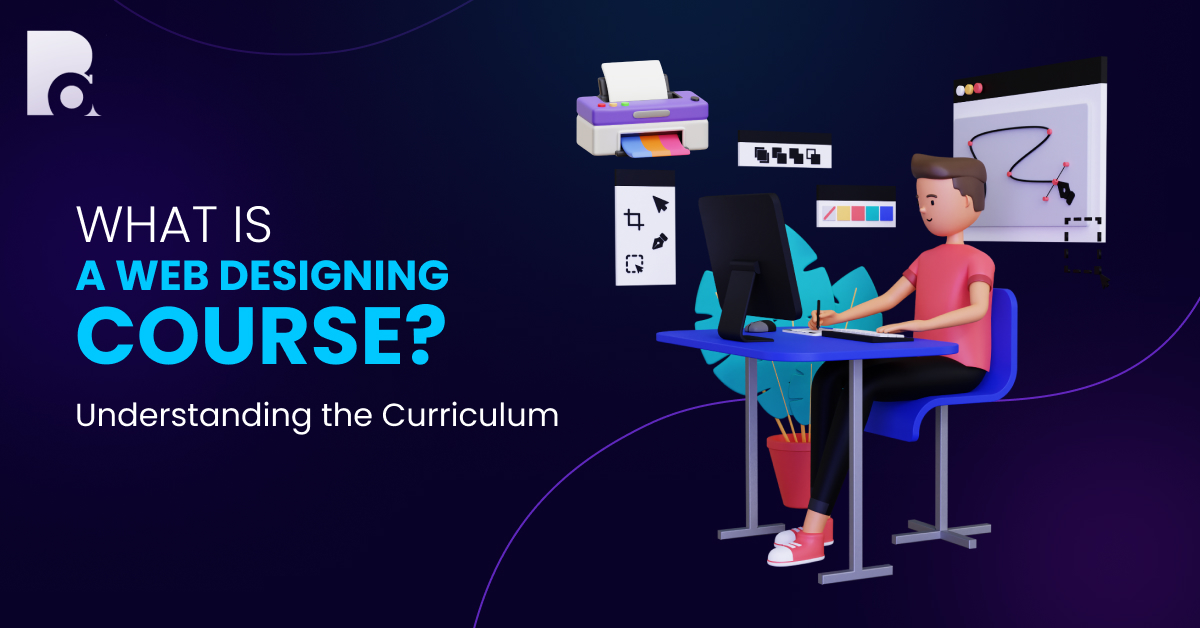
What is a Web Designing Course? Understanding the Curriculum
Sitting at the crossroads of creativity and technology, a web designer is involved in shaping the way users interact with digital spaces. Many know that a web designer basically designs the visible look and feel of websites, but there’s much more behind their role.
Other than looking after visuals, they need to make the site intuitive, accessible, and consistent on various devices. They work in coordination with developers so that design concepts result in functional interfaces and they manage tools like Photoshop and Illustrator to perfect each pixel. Responsive web design is central to their work for websites to be responsive across all types of devices, from mobile screens to wide-screen desktops.
Who is Eligible for a Web Designing Course?
Any creative person with some computing knowledge can enroll for a web design course. The target population will be students who are pursuing an IT qualification, people looking to change their careers into tech work immediately after graduation, and job seekers who wish to upskill in this in-demand field.
Technical knowledge of HTML, CSS, or JavaScript is always useful; but most web design courses start by teaching you everything from scratch. You would only require a flair for detail and some willingness to explore popular design tools. Figma or Adobe XD are widely used. Many people from non-technical backgrounds also switch to web designing careers.
What’s Included in the Curriculum of a Web Designing Course
If you enroll in a web designing course you can expect a broad, multi-layered curriculum that covers technical, visual, and UX-based skills. As a student, you will learn the necessary tools, programming languages, and design principles to help you become a successful competent designer who can produce respectable and functional websites. The coursework usually takes place in modules with progressive levels of difficulty, getting you started with basics and then going further into specialized topics.
1. Visual Design and Graphic Tools
Visual design is a basic aspect of the curriculum that trains students on Photoshop, a tool that enables editing of images and creation of graphics, and even page layouts. Photoshop is now indispensable -cropping product images, creating banners and ad creatives a lot is possible on this platform. You’ll also learn what is Illustrator, another sophisticated tool used to design vector graphics, such as logos or icons, which must stay sharp no matter their size.
At this point, you are taught the use of typography, color theory, and grid systems. Students become aware of how the specification of fonts, line spacing, and color palettes makes a difference to user perception and usability of a website. Knowing the underlying design principles allows them to develop interfaces that feel intuitive and look good.
2. User Interface (UI) and User Experience (UX) Design
It is no longer enough to have merely attractive websites. The designs should be a smooth user experience. This section takes students through UI and UX principles, explaining how a design choice influences the user journey. A very large part of the course deals with explaining what is Adobe XD used for. With this tool you learn to prototype interfaces so that their layout functions correctly before going into development.
Students who are wondering ‘What is Figma used for?’ will get thorough training on the design tool. Using Figma, the course will teach wireframing and mockup techniques as well as teaching students to experiment with multiple iterations of a site design. While this tool helps to create interfaces, that is not all it does. Figma is popular because it allows collaborative workflows between designers and clients, giving them real-time feedback during the design process.
3. HTML, CSS, and JavaScript
A great design is one part—it also needs to be converted into code. For this reason your course curriculum will also include front-end languages required to make web page structure using HTML and then style it using CSS. The websites are made dynamic because you can add in some functionality, like animations or form validation by using JavaScript.
From here, you are going to learn jQuery: it is actually a popular JavaScript library designed for making scripting easier. jQuery is still widely used for tasks like creating image sliders, modals, and interactive elements with fewer lines of code.
At this stage, students typically work on live projects-by building simple web pages or redesigning sites-by implementing what they have learned. The assignments require students to create mobile-friendly designs, testing their understanding of what is responsive web design, which ensures that websites look and function well across devices.
4. Responsive Web Design Techniques
Responsive design holds a huge place in modern courses in web designing. Students learn how to deal with media queries, how to structure layout with flexbox, and how to alter any element for the web according to the screen size it is being viewed on. Other areas would consist of browser compatibility for making sure that a site works well with Chrome, Safari, and Firefox.
While it may sound like a typical buzzword, responsive design is a non-negotiable skill today due to the fact that all users expect a seamless browsing experience on all devices. Exercises in this chapter also employ prototyping with flexible grids, so that students will know how to design sites that fluidly adapt from the smartphone to the tablet to the desktop.
5. Web Design Frameworks and Libraries
Students are taught to build efficient websites by getting them familiar with frameworks like Bootstrap. Instead of repeating boilerplate code in each new project, students learn to develop using pre-fabricated components like navbars and modals that one can easily customize to specific needs. Using frameworks like Bootstrap saves time and enforces design consistency-an indispensable requirement for large projects or when working on multiple team environments.
At this point, you will also learn how to use animations and transitions, working with both CSS-based and JavaScript-based libraries. It is here that jQuery will be reintroduced, giving students the choice to add elements that they think will make the web design interactive, such as drop-down menus, lightboxes, and fading carousels etc.
6. Design for Content Management Systems (CMS)
Many websites utilize the CMS, which usually involves WordPress as the basic application. Generally, an overall comprehensive course in web design teaches them to learn the designing and modification of templates. Such courses teach students to form the themes by the usage of HTML, CSS, or JavaScript, in alignment with the branding of a client. All kinds of plugin integrations are discussed in the courses since another easy and time-saving methodology is that it does not require an individual to write code for extensive functionalities.
so that students learn how to extend the functionality of the website they create, without needing to keep writing code for it.
7. SEO and Web Performance Optimization
Design does not function in a silo –SEO and performance both play equal roles for success on the website. All students learn the foundational requirements of on-page SEO that will get their sites optimized to rank well in a search engine. This includes page speed, optimizing images, and minification. With appropriate tools like Google Lighthouse, you will be taught to measure site metrics and any bottleneck that may negatively impact the user experience.
8. Project Management and Collaboration Tools
It’s rare for a web design project to be a solo endeavor. Using tools like Figma allows the entire team to collaborate without friction. Learners would understand the management of shared design space and, after submitting prototypes for a client, and making revisions based on client comments. In the case of the collaboration module most of the time, they also get familiar with this versioning control tool termed as Git through which quite a few individuals can perform their activities with the very same file without overwriting each other’s changes.
Project management also makes an appearance in this segment. Web designers should be able to be comfortable working within the timeline, managing expectations of the client, and multitasking with many projects. The great part of tools such as Trello or Asana is that they demonstrate to the designer how to stay organized, with some examples of how to stay on track.
9. Capstone Projects and Portfolio Building
Capstone projects are given towards the end of this course, where students actually apply what they have learned. This includes creating a whole website from scratch or designing an ecommerce store. It can also include redesigning a site that performs terribly. These projects will not contribute to any grade at the end but are critical in any designer’s portfolio, hence necessary while hiring for work or freelance purposes.
The students also get information on what to include in their portfolios. They present specific projects that exhibit both the technical and design skills. Some programs also offer portfolio review where industry professionals will provide a review and improve on the student’s work.
Industry Demand and Career Opportunities in Web Design
Web design is a big deal today, as most businesses are intent on creating impactful digital experiences. From e-commerce websites to personal portfolios, every brand needs visually appealing, functional designs that engage users and drive conversions. As a result, job roles for web designers are constantly evolving. Graduates of a web design course can explore roles such as UI/UX Designer, Front-End Developer, Web Graphic Designer, or even specialize in mobile-first design.
The growing importance of what is responsive web design gives opportunities to designers skilled in creating flexible interfaces. Many web designers prefer freelancing, and there are many platforms they can use to avail jobs that range from redesigning websites to creating a custom theme for a CMS platform. Experienced designers can move on to become Creative Directors in charge of leading multidisciplinary teams building complete digital experiences.
Figma and Adobe XD are some of the tools becoming standard, which is why companies want to hire web designers for collaborative projects working cross-functionally. Also, once you learn jQuery and are familiar with Bootstrap and other important framework environments, your skills will be even more in demand. Technical knowledge and creativity are both required in the current job market. So, web designers must remain up-to-date and continuously develop the latest skills.
Conclusion
A web design course provides the students with a complete set of job ready skills, best practices as well as the confidence needed to secure a long term-career in this field. Be it mastering Photoshop for visual design or teaching about what is Illustrator or what is Adobe XD—these are some of what you will learn in the course. It ensures that the student learns how to build responsive web designs magnificently suiting any screen size. Students can even learn jQuery and build responsive web designs that are modern, dynamic, developed using the latest frameworks.
By the end of the course, graduates would be technically equipped and enlightened with the concepts of collaboration, project management, and SEO for a better position in varied roles in the design world.
Also Read Low-Cost High-Value Web Designing Institute In Kolkata



